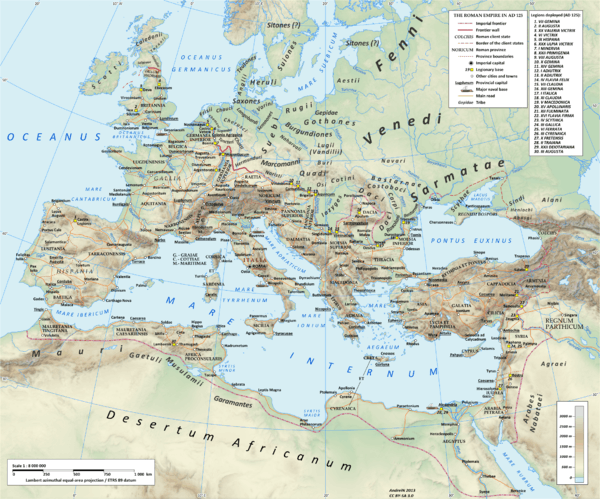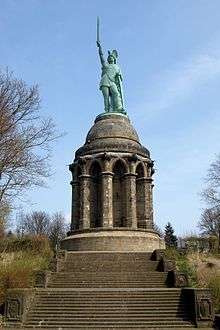Cherusci

The Cherusci (sometimes called the Cherusks) were a Germanic tribe that inhabited parts of the plains and forests of northwestern Germany, in the area possibly near present-day Hanover, during the 1st century BC and 1st century AD. Ethnically, Pliny the Elder groups them with their neighbours the Suebi and Chatti, as well as the Hermunduri, as Hermiones, one of the Germanic groupings said to descend from an ancestor named Mannus.[1] They led an important war against the Roman Empire. Subsequently they were probably absorbed into the tribal confederations such as the Franks and Allemanni.
Etymology
The etymological origin of the name Cherusci is not known with certainty. According to the dominant opinion in scholarship, the name may derive from the ancient Germanic word *herut (Modern English hart, i. e. "deer"). The tribe may have been named after the deer because it had a totemistic significance in Germanic symbolism.[2] A different hypothesis, proposed in the 19th century by Jacob Grimm and others, derives the name from *heru-, a word for "sword" (cf. Gothic hairus, Old English heoru).[3] Hans Kuhn has argued that the derivational suffix -sk-, involved in both explanations, is otherwise not common in Germanic. He suggested that the name may therefore be a compound of ultimately non-Germanic origin, connected to the hypothesized Nordwestblock.[4]
History

The first historical mention of the Cherusci occurs in Book 6.10 of Julius Caesar's De Bello Gallico, which recounts events of 53 BC. Caesar relates that he crossed the Rhine again to punish the Suebi for sending reinforcements to the Treveri. He mentions that the Bacenis forest (a relatively impenetrable Beech forest, possibly the Harz) separated the territory of the Cherusci from that of the Suebi. In 12 BC, the Cherusci and other Germanic tribes were subjugated by the Romans. They appear to have been living in the same homeland when Tacitus wrote, 150 years later, describing them as living east of the Chauci and Chatti. This is generally interpreted to be an area between the rivers Weser and Elbe.[5]
As Rome tried to expand in northern Europe beyond the Rhine, it exploited divisions within the Cherusci, and for some time the tribe was considered a Roman ally. At this time the tribe was split between Arminius (known in modern German as "Hermann der Cherusker", although his actual Germanic name was more likely Erminaz[6]) and Segestes. Arminius advocated breaking allegiance to Rome and declaring independence, while Segestes wanted to remain loyal. By about 8 AD, Arminius had gained the upper hand and began planning rebellion. Segestes repeatedly warned Publius Quinctilius Varus, the governor of Gaul, that rebellion was being planned, but Varus declined to act until the rebellion had broken out.
In the year 9, in the Battle of the Teutoburg Forest, an army of allied Germanic tribes under the command of Arminius (the Cherusci, Bructeri, Marsi, Sicambri, Chauci and Chatti) annihilated three Roman legions commanded by Varus. The legions' eagle standards, of great symbolic importance to the Romans, were lost. The numbers of these three legions, Legio XVII, Legio XVIII, and Legio XIX, were never used again.
After the mutinies of the German legions in the year 14, Germanicus decided, at the urging of his men, to march into Germany to restore their lost honor. In 15, after a quick raid on the Chatti, invaded the lands of the Marsi in 14 AD with 12,000 legionnaires, 26 cohorts of auxiliaries and eight cavalry squadrons. According to Tacitus (Annals 1, 51), an area 50 Roman miles wide was laid to waste with fire and sword: "No sex, no age found pity." A Legion eagle from Varus's defeat, either from the XVII or XVIII, was recovered. Then he began a campaign against the Cherusci. He received an appeal to rescue Segestes, who was besieged by Arminius. Segestes was rescued along with a group of relatives and dependents, including Thusnelda, Segestes' daughter and the wife of Arminius. Germanicus spared them and gave them land in Gaul. He then found the site of the Battle of Teutoburg Forest. His men buried the dead and built a funeral mound.
A series of battles followed. Inflicting minor casualties on the Romans, Arminius seemed to be gaining the upper hand, but in 16 Germanicus defeated Arminius at Idistaviso and at the Battle of the Angrivarian Walls. In AD 19, Adgandestrius, a chief of the Chatti, asked Rome for poison to kill Arminius. Tacitus claimed the request was refused on the "noble" grounds that (as related by Tacitus) "Romans take vengeance on their enemies, not by underhanded tricks, but by open force of arms." Following the decisive Roman victories, Arminius increasingly became embroiled in tribal disputes; his opponents accused him of trying to make himself king. In 21 Arminius "succumbed to treachery from his relations" (Tacitus) and a client king was appointed on the Germans by Rome.
After Arminius' death, the Romans left the Cherusci more or less to their own devices. In the year 47 the Cherusci asked Rome to send Italicus, the nephew of Arminius, to become king, as civil war had destroyed their nobility. He was initially well liked, but since he was raised in Rome as a Roman citizen he soon fell out of favor.
Tacitus writes of the Cherusci of his time (about 100 AD):
Dwelling on one side of the Chauci and Chatti, the Cherusci long cherished, unassailed, an excessive and enervating love of peace. This was more pleasant than safe, for to be peaceful is self-deception among lawless and powerful neighbours. Where the strong hand decides, moderation and justice are terms applied only to the more powerful; and so the Cherusci, ever reputed good and just, are now called cowards and fools, while in the case of the victorious Chatti success has been identified with prudence. The downfall of the Cherusci brought with it also that of the Fosi, a neighbouring tribe, which shared equally in their disasters, though they had been inferior to them in prosperous days.[7]
Claudius Ptolemy in his Geography, describes the Χαιρουσκοὶ and Καμαυοὶ (Cherusci and Chamavi) as living near each other and also near to "Mount Melibocus" (probably the Harz mountains) and to the Calucones, who lived on both banks of the Elbe.
The later history of the Cherusci is mostly unknown. In the 4th century AD they perhaps contributed to the formation of the Saxon people.
See also
References
- ↑ "Plin. Nat. 4.28". Perseus.tufts.edu. Retrieved 2013-12-31.
- ↑ Reallexikon der germanischen Alterturmskunde (1981), vol. 4, p. 430 ff., s.v. "Cherusker"; cf. also Rudolf Much, Herbert Jankuhn & Wolfgang Lange, Die Germania des Tacitus, Heidelberg: Winter, 1967, p. 411.
- ↑ Jacob Grimm, Geschichte der Deutschen Sprache, 2nd ed., Leipzig 1853, vol. 2, p. 426.
- ↑ Reallexikon der germanischen Alterturmskunde (1973), vol. 1, pp.420–421, s.v. "Arminius".
- ↑ Smith, William (1854), Dictionary of Greek and Roman Geography
- ↑ http://www.webcitation.org/query?url=http://www.geocities.com/Paris/Salon/2385/FAQ.html%23hermann&date=2009-10-25+09:25:32
- ↑ "Tac. Ger. 36". Perseus.tufts.edu. Retrieved 2013-12-31.
Sources
- Tacitus, Cornelius and Michael Grant, The Annals of Imperial Rome. New York: Penguin Books, 1989.
- Caesar, Julius et al. The Battle for Gaul. Boston: D. R. Godine, 1980.
- Wilhelm Zimmermann, A Popular History of Germany (New York, 1878) Vol. I
- Max Ihm, Cherusci. In: Paulys Realencyclopädie der classischen Altertumswissenschaft (RE). volume III,2, Stuttgart 1899, Sp. 2270–2272.
- Ralf Günther Jahn, Der Römisch-Germanische Krieg (9–16 n. Chr.). Diss., Bonn 2001.
- Peter Kehne, Zur Lokalisierung, Organisation und Geschichte des Cheruskerstammes. In: Michael Zelle (Hrsg.), Terra incognita? Die nördlichen Mittelgebirge im Spannungsfeld römischer und germanischer Politik um Christi Geburt. Akten des Kolloquiums im Lippischen Landesmuseum Detmold vom 17. bis 19. Juni 2004. Philipp von Zabern Verlag, Mainz 2008, ISBN 978-3-8053-3632-1, pages 9–29.
- Gerhard Neumann, Reinhard Wenskus, Rafael von Uslar, Cherusker. In: Reallexikon der Germanischen Altertumskunde (RGA). 2. Auflage. volume 4, Walter de Gruyter, Berlin – New York 1981, pages 430–435.
- Oberst Streccius, Cherusker. In: Bernhard von Poten (Hrsg.): Handwörterbuch der gesamten Militärwissenschaften. volume 2, Bielefeld/Leipzig 1877, page 235.
-
 "Cherusci". Encyclopædia Britannica. 6 (11th ed.). 1911. p. 89.
"Cherusci". Encyclopædia Britannica. 6 (11th ed.). 1911. p. 89.